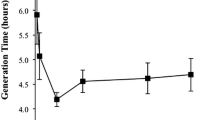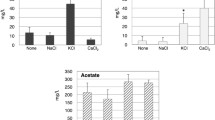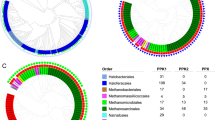Abstract
Cultures of Methanobacterium thermoautotrophicum (Marburg) growing on media low in potassium accumulated the cation up to a maximal concentration gradient ([K+]intracellular/[K+]extracellular) of approximately 50,000-fold. Under these conditions, the membrane potential was determined by measuring the equilibrium distribution of the lipophilic cation (14C) tetraphenylphosphonium (TPP+). This cation was accumulated by the cells 350-to 1,000-fold corresponding to a membrane potential (inside negative) of 170–200 mV. The pH gradient, as measured by equilibrium distribution of the weak acid, benzoic acid, was found to be lower than 0.1 pH units (extracellular pH=6.8). The addition of valinomycin (0.5–1 nmol/mg cells) to the culture reduced the maximal concentration gradient of potassium from 50,000-to approximately 500-fold, without changing the membrane potential. After dissipation of the membrane potential by the addition of 12C-TTP+ (2 μmol/mg cells) or tetrachlorosalicylanilide (3 nmol/mg cells), a rapid and complete efflux of potassium was observed.
These data indicate that potassium accumulation in the absence of valinomycin is not in equilibrium with the membrane potential. It is concluded that at low extracellular K+ concentrations potassium is not accumulated by M. thermoautotrophicum via an electrogenic uniport mechanism.
Similar content being viewed by others
Abbreviations
- TPP+ :
-
Tetra phenylphosphonium bromide
- DTE:
-
Dithioerythritol
- TCS:
-
3,5,3′,4′-Tetrachlorosalycylanilide
References
Bakker EP, Mangerich WE (1981) Interconversion of components of the bacterial proton motive force by electrogenic potassium transport. J Bacteriol 147:820–826
Bakker EP, Harold FM (1980) Energy coupling to potassium transport in Streptococcus faecalis. J Biol Chem 255:433–440
Balch WE, Wolfe RS (1979) Transport of coenzyme M (2-mercaptoethanesulfonic acid) in Methanobacterium ruminantium. J Bacteriol 137:264–273
Balch WE, Fox GE, Magrum LJ, Woese CR, Wolfe RS (1979) Methanogens: Reevaluation of a unique biological group. Microbiol Rev 43:260–296
Benyoucef M, Rigaud JL, Leblanc G (1982a) Cation transport mechanisms in Mycoplasma mycoides var. Capri cells. Na+ dependent K+ accumulation. Biochem J 208:529–538
Benyoucef M, Rigaud JL, Leblanc G (1982b) Cation transport mechanisms in Mycoplasma mycoides var. Capri cells. The nature of the link between K+ and Na+ transport. Biochem J 208:539–547
Blaut M, Gottschalk G (1984a) Coupling of ATP synthesis and methane formation from methanol and molecular hydrogen in Methanosarcina barkeri. Eur J Biochem 141:217–222
Blaut M, Gottschalk G (1984b) Protonmotive force driven synthesis of ATP during methane formation from molecular hydrogen and formaldehyde or carbon dioxide in Methanosarcina barkeri. FEMS Microbiol Lett 24:103–107
Brandis A, Thauer RK, Stetter KO (1981) Relatedness of strains ΔH and Marburg of Methanobacterium thermoautotrophicum. Zbl Bakt Hyg I Abt Orig C 2:311–317
Butsch BM, Bachofen R (1982) Measurement of the membrane potential in Methanobacterium thermoautotrophicum. Experientia 38:1377
Epstein W, Laimins L (1980) Potassium transport in Escherichia coli: diverse systems with common control by osmotic forces. TIBS 5:21–23
Erecińska M, Deutsch CJ, Davis JS (1981) Energy coupling to K+ transport in Paracoccus denitrificans. J Biol Chem 256:278–284
Harold FM (1972) Conservation and transformation of energy by bacterial membranes. Bacteriol Rev 36:172–230
Harold FM (1977a) Membranes and energy transduction in bacteria. Curr Top Bioenerg 6:83–149
Harold FM (1977b) Ion currents and physiological functions in microorganisms. Ann Rev Microbiol 31:181–203
Harold FM, Altendorf K (1974) Cation transport in bacteria: K+, Na+, H+. Curr Top Membr Transport 5:1–50
Hassan HM, MacLeod RA (1975) Kinetics of Na+-dependent K+ ion transport in a marine pseudomonad. J Bacteriol 121: 160–164
Heefner DL (1982) Transport of H+, K+, Na+ and Ca2+ in Streptococcus. Mol Cell Biochem 44:81–106
Hugentobler G, Heid I, Solioz M (1983) Purification of a putative K+-ATPase from Streptococcus faecalis. J Biol Chem 258: 7611–7617
Jarrell KF, Sprott GD (1981) The transmembrane electrical potential and intracellular pH in methanogenic bacteria. Can J Microbiol 27:720–728
Jarrell KF, Sprott GD (1982) Nickel transport in Methanobacterium bryantii. J Bacteriol 151:1195–1203
Jarrell KF, Sprott GD (1983a) The effects of inophores and metabolic inhibitors on methanogenesis and energy-related properties of Methanobacterium bryantii. Arch Biochem Biophys 225:33–41
Jarrell KF, Sprott GD (1983b) Measurement and significance of the membrane potential in Methanobacterium bryantii. Biochim Biophys Acta 725:280–288
Jarrell KF, Brid SE, Sprott GD (1984) Sodium-dependent isoleucin transport in the methanogenic archaebacterium Methanococcus voltae. FEBS Lett 166:375–361
Kobayashi H (1982) Second system for potassium transport in Streptococcus faecalis. J Bacteriol 150:506–511
Kroll RG, Booth IR (1983) The relationship between intracellular pH, the pH gradient and potassium transport in Escherichia coli. Biochem J 216:709–716
Laimins LA, Rhoads DB, Altendorf K, Epstein W (1978) Identification of the structural proteins of an ATP-driven potassium transport system in Escherichia coli. Proc Natl Acad Sci USA 75:3216–3219
Lolkema JS, Abbing A, Hellingwerf KJ, Konings WN (1983) The transmembrane electrical potential in Rhodopseudomonas sphaeroides determined from the distribution of tetraphenylphosphonium after correction for its binding to cell components. Eur J Biochem 130:287–292
Padan E, Zilberstein D, Schuldiner S (1981) pH homeostasis in bacteria. Biochim Biophys Acta 650:151–166
Pressman B (1976) Biological application of ionophores. Ann Rev Biochem 45:501–530
Rhoads DB, Epstein W (1977) Energy coupling to net K+ transport in Escherichia coli K-12. J Biol Chem 252:1394–1401
Rottenberg H (1976) The driving force for proton(s) metabolites contrasport in bacterial cells. FEBS Lett 66:159–163
Rottenberg H (1979) The measurement of membrane potential and ΔpH in cells, organelles, and vesicles. In: Fleischer S, Packer L (eds) Methods in enzymology, vol LV. Academic Press, New York San Francisco London, pp 547–569
Scherer P, Lippert H, Wolff G (1983) Composition of the major elements and trace elements of 10 methanogenic bacteria determined by inductively coupled plasma emission spectrometry. Biological Trace Element Research 5:149–163
Schönheit P, Perski HJ (1983) ATP synthesis driven by a potassium diffusion potential in Methanobacterium thermoautotrophicum is stimulated by sodium. FEMS Microbiol Lett 20:263–267
Schönheit P, Moll J, Thauer RK (1980) Growth parameters (K s, μmax, Y s) of Methanobacterium thermoautotrophicum. Arch Microbiol 127:59–65
Shioi JI, Matsuura S, Imae Y (1980) Quantitative measurements of proton motive force and motility in Bacillus subtilis. J Bacteriol 144:891–897
Silver, S (1978) Transport of cations and anions. In: Rosen BP (ed) Bacterial transport, Microbiology Series 4. Dekker Inc, New York Basel, pp 221–324
Sorensen EN, Rosen BP (1980) Effects of sodium and lithium ions on the potassium ion transport systems of Escherichia coli. Biochemistry 19:1458–1462
Sprott GD, Jarrell KF (1981) K+, Na+, and Mg2+ content and permeability of Methanospirillum hungatei and Methanobacterium thermoautotrophicum. Can J Microbiol 27:444–451
Suelter CH (1970) Enzymes activated by monovalent cations. Science 168:789–795
Wieczorek L, Altendorf K (1979) Potassium transport in Escherichia coli. Evidence for a K+-transport adenosine-5′-triphosphatase. FEBS Lett 98:233–236
Author information
Authors and Affiliations
Rights and permissions
About this article
Cite this article
Schönheit, P., Beimborn, D.B. & Perski, HJ. Potassium accumulation in growing Methanobacterium thermoautotrophicum and its relation to the electrochemical proton gradient. Arch. Microbiol. 140, 247–251 (1984). https://doi.org/10.1007/BF00454936
Received:
Accepted:
Issue Date:
DOI: https://doi.org/10.1007/BF00454936




